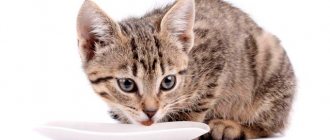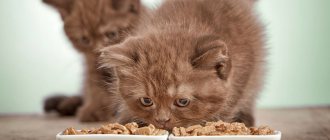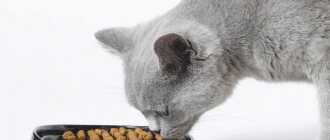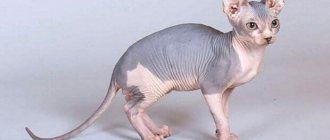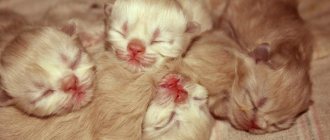Starting from three to four months of age, kittens begin to grow actively. There is a set of muscle mass, strengthening and growth of the skeletal system, and the replacement of milk teeth with permanent ones. During this same period, there is an increase in the motor activity of kittens. They begin to play and frolic a lot, which entails a lot of energy and strength.
The quality of nutrition during this period is of particular importance. Its further development and health status depend on what food the pet will receive during the period of active growth. Therefore, kittens should receive age-appropriate nutrition rich in vitamins and microelements.
Features and rules of feeding
When organizing food for a small pet, you need to take into account some very important points:
- The frequency of feedings directly depends on the activity and age of the baby - the smaller and more active he is, the more often he needs to be fed.
- It is important to determine the balance. The baby should not overeat or undereat. Malnutrition is fraught with developmental failure and poor health, and overeating leads to obesity and metabolic disorders.
- It is advisable to immediately decide on the choice of diet - natural food or ready-made food intended for kittens.
- The introduction of complementary foods into a kitten's diet should be careful and gradual. You cannot simultaneously introduce several new products to its menu. It is recommended to alternate feeding different foods.
- It is unacceptable to lay out the entire daily amount of food at once. Kittens do not yet know how to control their appetite and may overeat. Help your baby and divide the daily amount of food into portions that are served at the right time.
- The kitten can get burned, watch the temperature of the food.
- The diet of an actively growing kitten must contain a sufficient amount of nutrients, vitamins and microelements.
The baby should always have clean drinking water in a separate bowl. You can’t pour water once a day, it stagnates and can spoil.
Solid food feeding
As soon as the kitten has its first sharp teeth, you can gradually give it other foods other than milk. There are no unusual products in this complementary food. It is very important that the animal's food is warm. You can feed him well-cooked oatmeal with the addition of hard-boiled egg yolk. Cottage cheese diluted with warm milk, it is advisable to grind it with a teaspoon until it becomes mushy. Ground beef, pour boiling water over it, or freeze it in the refrigerator for 2 days to kill some harmful bacteria.
Norms and feeding regimen
The average daily amount of food for a kitten is selected depending on many conditions - activity, age, size, health, breed. On average, it is recommended to feed a kitten food per day at the rate of 20 g of food/1 kg of weight. Most often, babies need 40 g of food per day, approximately 10 g per meal. But these are average values. It is important to take into account all available factors: appetite, activity, health status, etc.
As for the feeding regimen, three-month-old kittens are fed more often, about 5-6 times a day, while four-month-old kittens need 4 feedings a day.
How much does a kitten weigh?
Gradual and sufficient weight gain is the main indicator of proper development. If you know the age and breed of the kitten, just weigh it on the scale.
It is advisable to weigh kittens weighing up to 1 kg on electronic kitchen scales that have a small error. To do this, use either a special container that comes with the scales, or a suitable plastic container.
Larger pets can also be weighed on household floor scales. As a last resort, you can weigh yourself, and then with your pet in your arms - and calculate the difference.
It is believed that until the age of six months, a kitten gains, on average, 100 grams of weight per week. After 6 months, the growth of a kitten of most breeds almost stops, but the weight continues to increase due to an increase in muscle mass.
However, there are breed characteristics - for example, Maine Coons grow very slowly and only by two years, or even later, gain their final weight and height. So for more accurate information, it is better to contact the breeder or a specialized website for the breed.
Here is a table showing the approximate weight parameters of kittens of different breeds by month. You can focus on it when determining the norm of development of a kitten.
Kitten weight table
| Development of kittens in the first year of life | ||||||
| Age | Weight of cats, g | Cats weight, g | ||||
| average | big | very large | average | big | very large | |
| 4 weeks | 550 | 630 | 820 | 450 | 560 | 740 |
| 6-8 weeks | 1000 | 1230 | 1500 | 900 | 1150 | 1400 |
| 10-12 weeks | 1350 | 1800 | 2300 | 1200 | 1700 | 2300 |
| 14-16 weeks | 1700 | 2700 | 3800 | 1500 | 2600 | 3600 |
| 5 months | 2050 | 3200 | 5500 | 1800 | 2900 | 4300 |
| 6 months | 2400 | 3900 | 6000 | 2100 | 3200 | 4500 |
| 7 months | 2750 | 4200 | 6500 | 2400 | 3500 | 4900 |
| 8 months | 3100 | 4500 | 6900 | 2700 | 3800 | 5200 |
| 9 months | 3450 | 5000 | 7000 | 3000 | 4100 | 5500 |
| 10 months | 3800 | 5200 | 7700 | 3200 | 4200 | 5800 |
| 11 months | 4050 | 2600 | 8000 | 3350 | 4300 | 6100 |
| 12 months | 4500 | 5700 | 9000 | 3500 | 4500 | 6800 |
| 18 months | 6000 | 9500 | 4700 | 7000 | ||
Diet selection and menu planning
First of all, you need to decide what you are going to feed your pet - ready-made kitten food or natural food, since mixing them is not recommended. Or ready-made industrial rations - or natural food! The fact is that different foods are digested differently.
To digest natural food, you do not need additional water, while to digest dry food you need to drink plenty of water. If the type of food changes frequently, the gastrointestinal tract of the kitten’s fragile body may not have time to rebuild, and as a result, various digestive problems are possible.
It is also unacceptable to combine different types of food. This is fraught with the occurrence of digestive insufficiency and the intake of excess vitamins and minerals into the body.
What to feed a four month old kitten
If your kitten is less than a year old, it is best to feed him kitten formula or kitten food. This will ensure that your growing kitten gets the nutrition he needs. Unlike food for adult cats, food for kittens has a special composition of nutrients to support their rapidly growing bodies.
At the age of 4 months, it is best to feed kittens the food recommended by your veterinarian. This will prevent any adverse reactions, especially if you are switching your kitten to a new food product.
In addition to food, hydration is important for raising kittens. Always have a bowl of cool, clean water or a water fountain available if the kitten does not touch the bowl. Please note that four month old kittens should not be given cow's milk because cats cannot digest lactose and this will only cause stomach upset.
Natural nutrition
During the period of teeth change, the baby’s body needs solid food, mainly protein and, without fail, various dairy products. If your pet cannot tolerate whole cow's milk, you can replace it with fermented milk products. The baby’s “food basket” should contain lean meat (poultry, beef, rabbit, etc.), eggs, vegetables, and cereals. The meat part should make up more than 50% of the diet, vegetables and cereals - less than 50% of the daily portion.
It is unacceptable to feed a kitten food from your table. Human food can cause digestive problems in a baby.
A kitten definitely needs meat. Meat products can be given both boiled and raw. It should be lean meat: beef, rabbit, lamb, chicken or turkey fillet. It is better to avoid pork due to its fat content and the risk of helminth infection. Starting from the age of three months, kittens can be given raw meat, but it must first be well frozen. You don’t have to grind the products into minced meat, but simply cut them into pieces.
Dairy products are the main suppliers of calcium; during the period of active growth of the skeletal system and teeth change, their presence in the diet is of particular importance. It is better to choose low-fat products. If your baby does not digest milk well, replace it with fermented milk products (yogurt, kefir, fermented baked milk, etc.). Eggnog made from cottage cheese, milk and egg yolk is very useful for kittens. It's delicious and very nutritious. It is permissible to occasionally offer your small pet small portions of low-fat sour cream and cheese.
Vegetables are very useful, primarily as a source of vitamins and fiber, but pets do not always like the taste of them. You can get out of this situation by adding pureed vegetables (pumpkin, cabbage, carrots) to the main dish, or cooking porridge in vegetable broth.
Egg yolk can be given either boiled or raw. This is a very nutritious product, the most valuable part of a chicken egg.
Low-fat fish. It is better to choose sea fish, as it is less bony and does not carry the risk of infection with worms. But it is not recommended to offer fish too often; give it no more than once a week.
Cereals in the form of various porridges - in milk, vegetable or meat broths. The most suitable ones are semolina and rice; it is better to avoid legumes and rolled oats. Legumes are difficult to digest and cause bloating, and rolled oats are overly rich in carbohydrates.
Fresh green grass is needed to cleanse the gastrointestinal tract. You can grow it yourself or buy oat and wheat sprouts in a store or veterinary pharmacy.
Vegetable oil, which has a choleretic and mild laxative effect, can be added to the main dish in small quantities to improve the digestion process.
What to exclude from a kitten's diet?
There are a number of products whose presence in the diet of small pets is either completely unacceptable or acceptable in very limited quantities.
Unacceptable Products
- Any fatty food (meat, fish, lard, etc.).
- Bones. Meat products in a baby’s diet should be exclusively in the form of fillets. Eating bones can lead to very serious health problems.
- Whole cow's milk. It is quite fatty and often simply is not absorbed by the kittens’ body, causing intestinal upset.
- Salty, smoked, spicy foods, such as sausage.
- Canned food intended for human consumption.
- Everything is fried.
- Tomatoes and eggplants.
- Corn grits.
- Sweets.
Products allowed in limited quantities
- Hercules and legumes.
- River fish.
- Potato.
There are foods that should not be given under certain conditions. So, in case of diarrhea, it is necessary to exclude fermented milk products from the diet, and in case of constipation, solid foods rich in carbohydrates and starch.
What specific products and in what volume will be present in your little pet’s diet is up to you, but there are standard recommendations for creating a menu for a 3-4 month old kitten.
| Product name | Quantity | Frequency of use |
| Meat (beef) | 40-80 g | every day |
| Milk. Fermented milk products | 100g | every day |
| Vegetable oil | half a teaspoon | in one day |
| Chicken (minced or pieces) | 40-120g | in one day |
| Puree vegetables | 20-30g | in one day |
| Egg yolk | 1 PC | once a week |
| Cereals (porridge) | 100g | in 1 week |
| Fish (sea) | 100g | once a week |
| Liver | 50g | in 1 week |
The table shows average values. The amount of food can be changed in one direction or another by 5-10%, depending on the age of the kitten, its weight, and activity.
Basic rules of care
It is necessary to accustom the kitten to the bowl, not allowing him to take food in other places. Your pet may also refuse to eat from it if the container is dirty or inconveniently located. Therefore, make sure that the bowl is in a place where there are no drafts, or not on a walkway where household members could accidentally touch the kitten. The bowl needs to be washed regularly.
The play area and the feeding area should be located separately from each other so that the kitten does not spread leftover food around the room.
How many times a day should you feed a kitten?
Babies up to 3-4 months need to be fed 8-10 times a day due to the fact that their digestive system is still very weak and cannot digest a large amount of food at once. In the future, you can reduce the number of meals to 3-4 times a day.
Kitten food table
When creating a menu for small kittens, you can rely on the following table:
| Product | Can I give it to a kitten? |
| banana | No |
| borsch | No |
| broccoli | Yes |
| buckwheat | Yes |
| baby food | Yes |
| potato | No |
| semolina | No |
| carrot | Yes |
| cucumber | Yes |
| liver | Yes |
| ground meat | Yes |
| bread | No |
| egg | Yes |
| apple | Yes |
Ready-made feed
There are a huge number of opinions regarding which food is better - ready-made or natural. As for industrial products, the advantages here are obvious - a complete balanced diet and ease of use. The disadvantages include the presence of synthetic food additives in some feeds.
If you have chosen to feed your pet industrial food, you should consider some rules for their use.
- Do not combine dry and wet food in your diet.
- Do not change the brand of the product.
Read the manufacturer's recommendations carefully. Starting from the age of four months, the kitten can give out the entire daily portion of dry food immediately, since kittens by this time are already able to control their appetite. Wet food should be given in portions equal to a single volume and in a heated form. In order not to harm your pet’s health, it is better to choose proven and reliable manufacturers, such as: NutroChoice, RoyalCanin, Purina, Acana. The product lines of these manufacturers include both dry and wet diets. Among the most popular brands that produce food for kittens are:
- Canadian brand "Akana". The company's products belong to the super-premium category and represent a complete, balanced diet with a low level of allergenicity. Products are made from whole, fresh raw materials of plant and animal origin. Meat component - at least 70%, the rest - vegetables, seaweed, fruits, cereals, eggs. The recipe is enriched with unsaturated fatty acids, vitamins, and microelements.
- French brand Royal Canin. The optimal content of nutrients necessary for the development and growth of kittens puts the products of this brand on a par with natural nutrition. The manufacturer recommends using the food starting from the age of four months for the kitten. The company's product line also includes a series of veterinary foods recommended for consumption based on a specific disease.
Further complementary feeding
So, time flies very quickly, and in a couple of months the kitten turned from a little fool into a charming playful creature. Now he needs more and more strength and energy, so his nutrition should be different, and a new product should be introduced weekly. They try to give boiled lean chicken, rabbit or turkey; low-fat sour cream, boiled beef liver, boiled fish or poached for a minute, separated from the bones. Boiled and chopped chicken or quail egg. Pumpkin puree with milk.
Any unfamiliar food should be given to a kitten in small doses and its behavior and well-being should be carefully observed. If the influence of a new bait negatively affects him, it is best to exclude him from the diet.
Age 3-6 months
At this point, the kitten's teeth and jaws are fully formed. Therefore, you can forget about the grater. But you'll have to pick up a knife. Because pieces that are too large will only be slobbered on and thoroughly chewed, but they will never get into the kitten’s stomach.
But now you don’t have to necessarily cook the meat and vegetable components of the menu. Of course, you will still have to cook the porridge, because kittens do not eat raw cereals. Raw fish is added to the diet. Strictly sea and boneless. River fish is contraindicated!
The milk is completely removed. It is replaced with low-fat cottage cheese or fermented milk products. You can sometimes give egg whites, raw ones. But teenage kittens often become indifferent to eggs in general. But at this time, unexpected taste habits are formed. Therefore, it is very important now to diversify your pet’s menu as much as possible. Otherwise, he will get used to one product and simply ignore the rest.
By the way, there are many known cases when kittens after 3 months demanded completely non-cat products:
- corn
- honey
- chocolate
- raw potatoes
- sunflower seeds
- fresh cucumbers
- dried fruits
Every normal person understands that such nutrition does not contribute to the full development and good growth of a kitten. Some make excuses by feeding the fluffy another candy: “Well, he loves it! »
You never know who loves it! But cats also have diabetes, obesity, urolithiasis and other human diseases. And they do not arise on their own. Domestic cats are fed by humans, which means that it is he who is to blame for the pet’s illness.
Do you want to pamper your kitten? Give him a prohibited non-cat product. But very little and very rarely. Let it remain a delicacy or a reward, but not a permanent menu item.

